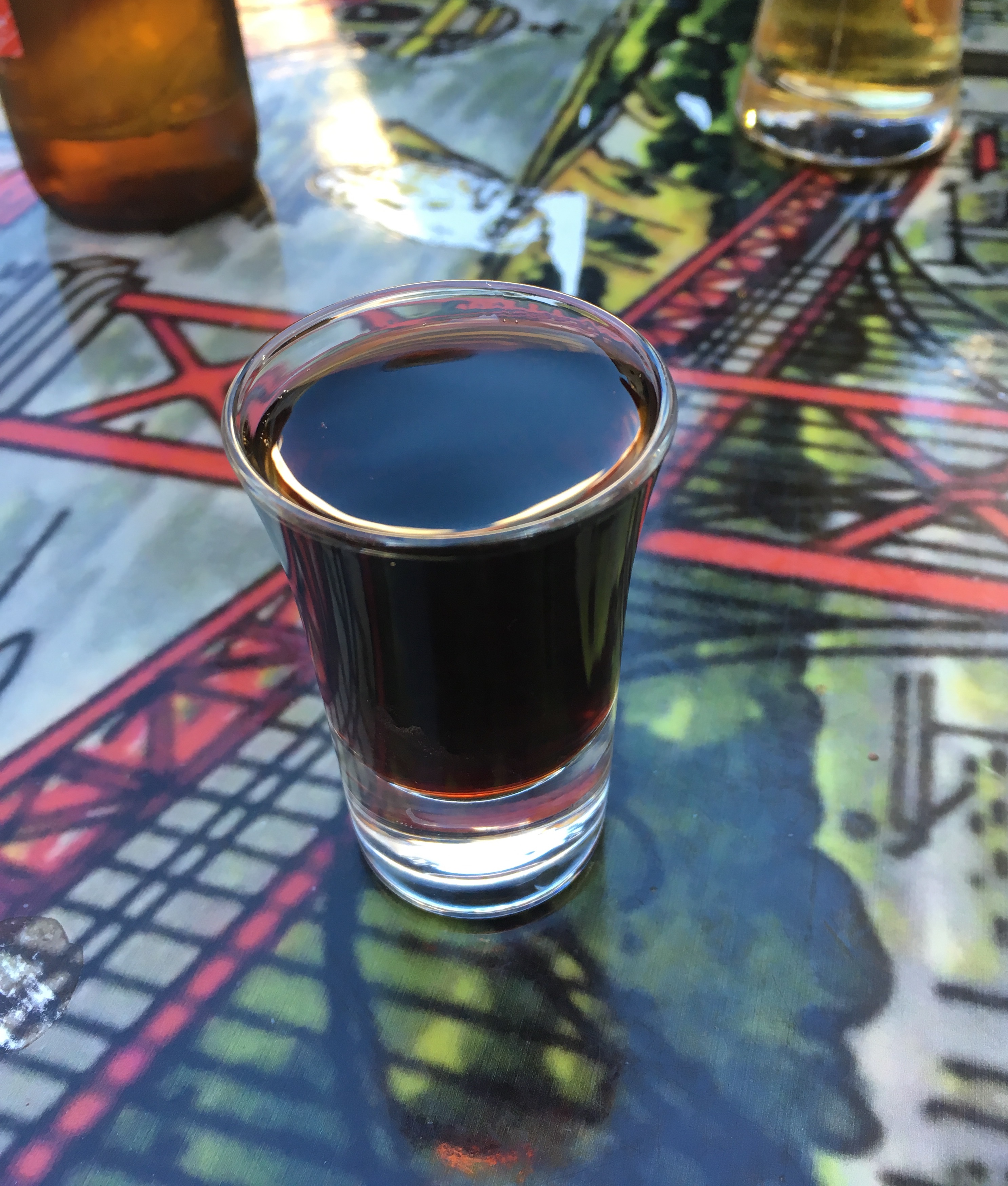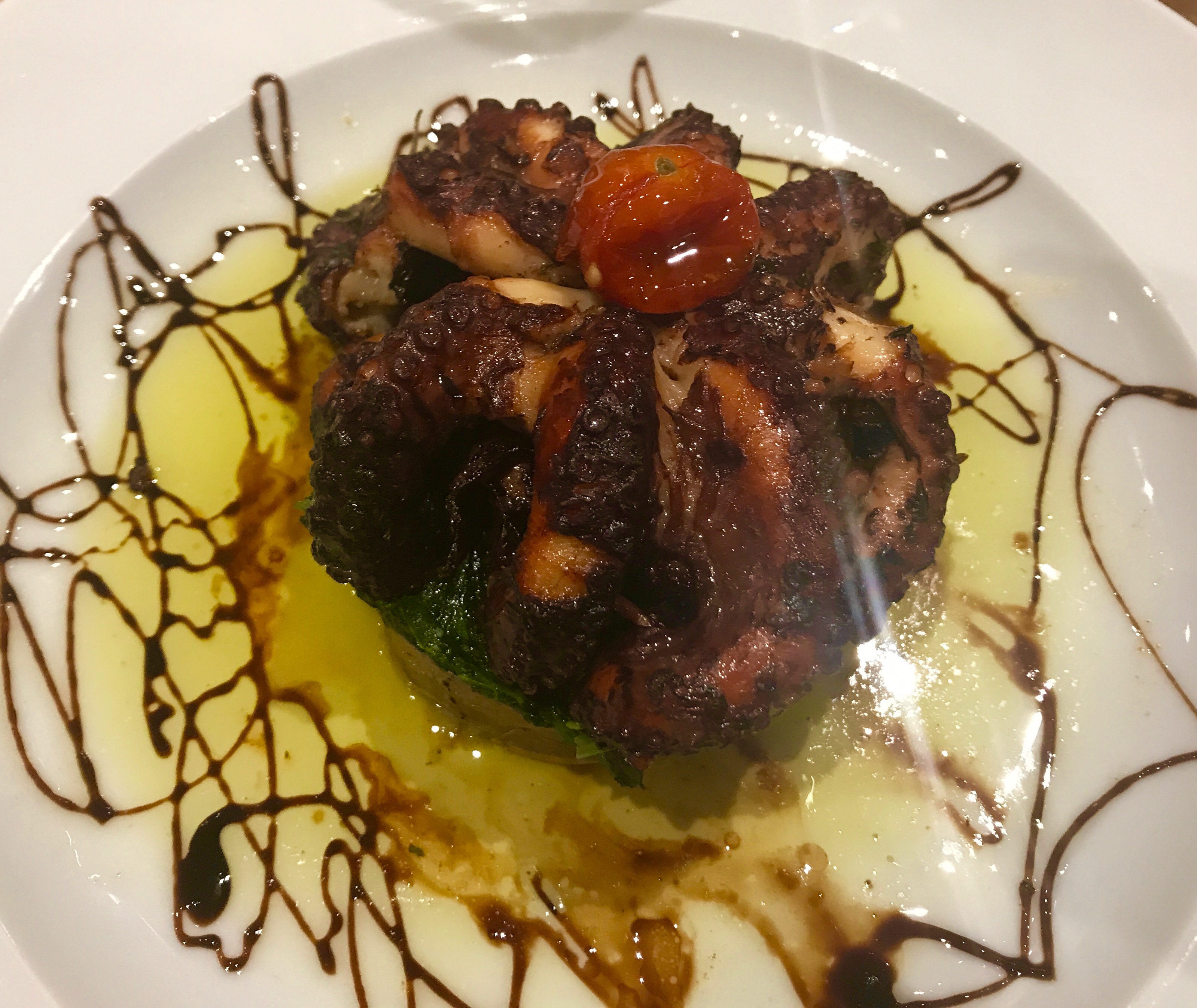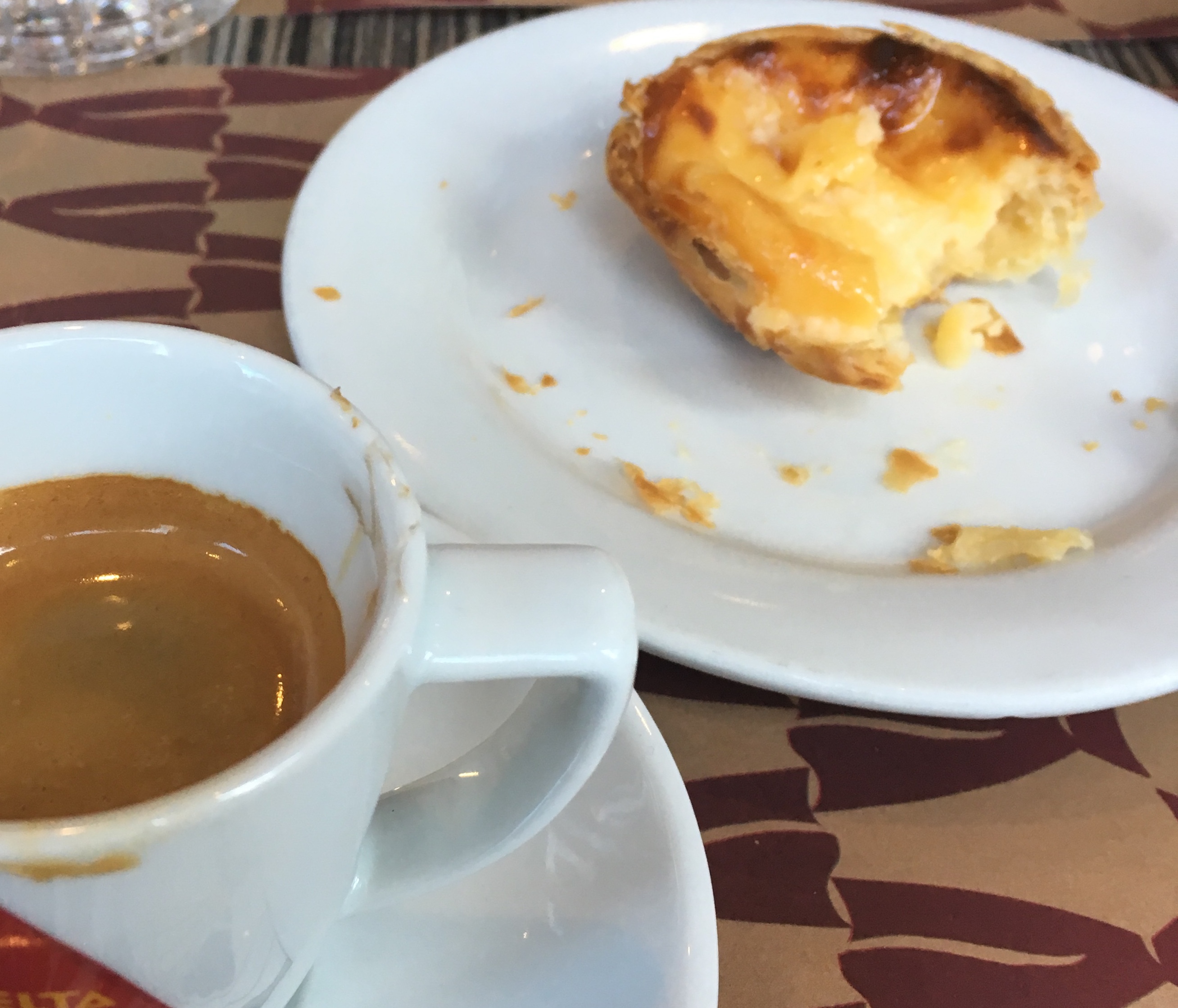A passion for travel allows for the discovery of places and people that make a difference in the perception of your own life. Numerous travel guides are readily available to give you practical information regarding transportation, hotels and tourist attractions. Instead, my intention is to give you simple, first-hand information and share my personal experience in travel. I will focus on unusual sites, extraordinary people, local food finds, budget friendly tips …and splurges worth your while. I will give you different view point on travel which will hopefully simplify your journey while upgrading your experience. www.simplytravelabroad.com
SIMPLY PORTUGAL
Very few places in Europe can be considered a bargain for travelers but still, the number of visitors don’t reflect a downward trend in tourism. Europe is Europe, and when a good deal comes along, we all jump for it. For the budget traveler, Portugal is the jackpot of all bargains in Europe. Prices are low, quality is high, food is excellent, it’s a win-win situation. As a first-time wanderer in this region, I enjoyed getting to know the friendly people, seeing the beautiful sights and as always, concentrating on the great food and wine finds in the region.
Lisbon: Colorful Sights, Soulful Fado and Ginjinha.
We arrived in the Rossio neighborhood in the central part of the city and a great place to stay if this is your first visit. The friendliness of the Portuguese was reflected immediately by our cab driver. He proudly described the area as he skillfully navigated his way from the airport. Because of a recent hiking accident, I was still on crutches and the driver insisted on dropping me off in the front of the hotel even though he had to maneuver through a one-way street. So, still with much ability, he backed up all the way the busy cobblestone-paved street!
Rossio is alive with energy. Restaurants line the streets with red checkered tablecloths on the closely-placed outdoor tables. Menus are posted visibly so tourists can select the food and price range their budget allows. This is also the neighborhood where you can enjoy the local specialty, Ginjinha, or as the locals call Ginja, a sweet cherry liqueur enjoyed in shot glasses. A single shot takes you back about 1 to 2 Euros depending on where you drink it. It’s good everywhere.
With my temporary reduced mobility, we opted to take a tour of the hilly city on a Tuk-Tuk. This wildly decorated mix of a Vespa and a golf cart is the ideal way to see the sights. You will find them lining up the squares and train stations where the tourists arrive. The tour can range from 50 to 70 Euros for the six-seater cart. Share the tour with other passengers and this becomes a great bargain. Our driver was excellent, spending 90 minutes steering us through wildly hilly streets, full of photo ops and history. His passion for this city was intoxicating, he was clearly proud of his heritage.
The Alfama neighborhood is famous for Fado, the spiritual and stirring music interpreted by soulful singers. Clearly this is where tourists abound but don’t let this deter you from booking a dinner show. You will quickly learn the proper Fado etiquette that calls for waiters to stop serving in order for patrons to watch in complete silence while the Fado singer pours his or her heart out in a stirring melody. No worries, this is skillfully orchestrated with numerous breaks to allow you to enjoy your meal.
I opted to make reservations at Povo, a casual place to eat and listen to artists in residence who belt out their Fado tunes. This is a relaxed atmosphere where serious students of Fado rehearse in the basement hallways next to the bathroom entrance, the food is consistent and non-pretentious, and the price is right. We were most pleasantly surprised by the quality of the singer who belted his heart out for the captivated audience. Check out Jonas Lopes on Facebook and www.Povolisboa.com
Garlicky Seafood, Pasteis de Bacalhau and Pasteis de Nata
It is said that Portugal has over 1,000 ways to prepare bacalhau or cod fish. Everywhere you turn, you see it advertised. Enticing croquettes, fried, served with eggs and olives in a casserole (a brass), with chick peas… you name it, cod fish is king here! And never mind the fact that cod fish is not found in the area waters, it is imported from the northern countries. I can tell you that I tried in many recipes but got distracted from it by the many other types of fresh seafood.
Seafood is featured in Portugal because, frankly, it is fresh, plentiful and some of the best in the world. After his recent visit to Portugal, my son recommended to try Cervejaria Ramiro www.cervejariaramiro.pt and it was an excellent tip. The Uber driver was surprised we would even try the place without a reservation, but we pushed our luck. Sunday brunch is popular here and as we approached we noticed about 30 people already in line. Our wait was only 20 minutes and we were ushered in to what looked like a small area, but one floor above opened up to a large dining room. The white tablecloths and embroidered napkins gave the place a feeling of old elegance. Don’t be fooled, this place is no stranger to modern technology. We are handed a menu on an iPad, and selected our language of choice. The menu is well organized and colorful, but all the items are listed by…kilogram, not price! At first glance it is hard to gage what or how much to order but the waiters are experts and advise you on quantity and selection. No one rushes you or pushes you to order more than you can handle. When the food arrives, you are presented with seafood heaven on a plate: grilled, buttered, garlicky heaven! At the end of the meal, the price tag was much less than we expected. A good find indeed!
Another great food find was a small, out of the tourist radar place called Coimbra Taberna www.coimbrataberna.pt Even after all the great meals we had in Portugal, this was in the top three restaurant finds. The grilled octopus over polenta was one of the best dishes by far. To add to the mood of the place, live music is played on weekends. A must stop in your travels.
One of the most economical and cultural ways to taste food when you are traveling is to hit the local markets and Lisbon is no exception. The Mercado da Ribeira, an old market which underwent a modern makeover to be transformed into a giant food court. People of all ages fill the long shared tables late into the night order from the multitude of restaurant kiosks on the periphery of the enormous building. We followed their lead and tasted the delicious raw oysters, Portuguese cured ham and other delightful fare.
In Portugal, it seems that sweets are consumed all day long. From the morning breakfast pastries to the late afternoon coffee and snacks, the Portuguese love their cookies and cakes. The most notable is the Pastel de Nata, a flaky filo dough filled with sweet custard invented by the monks in the Belen area of Lisbon. I have to admit, the best one I tasted was not in Lisbon but in Porto. Warm right out of the oven in a coffee shop with the catchy name “The World Needs Nata” on the Rua de Flores. You won’t regret the calories
Ah Porto! The little jewel of Portugal.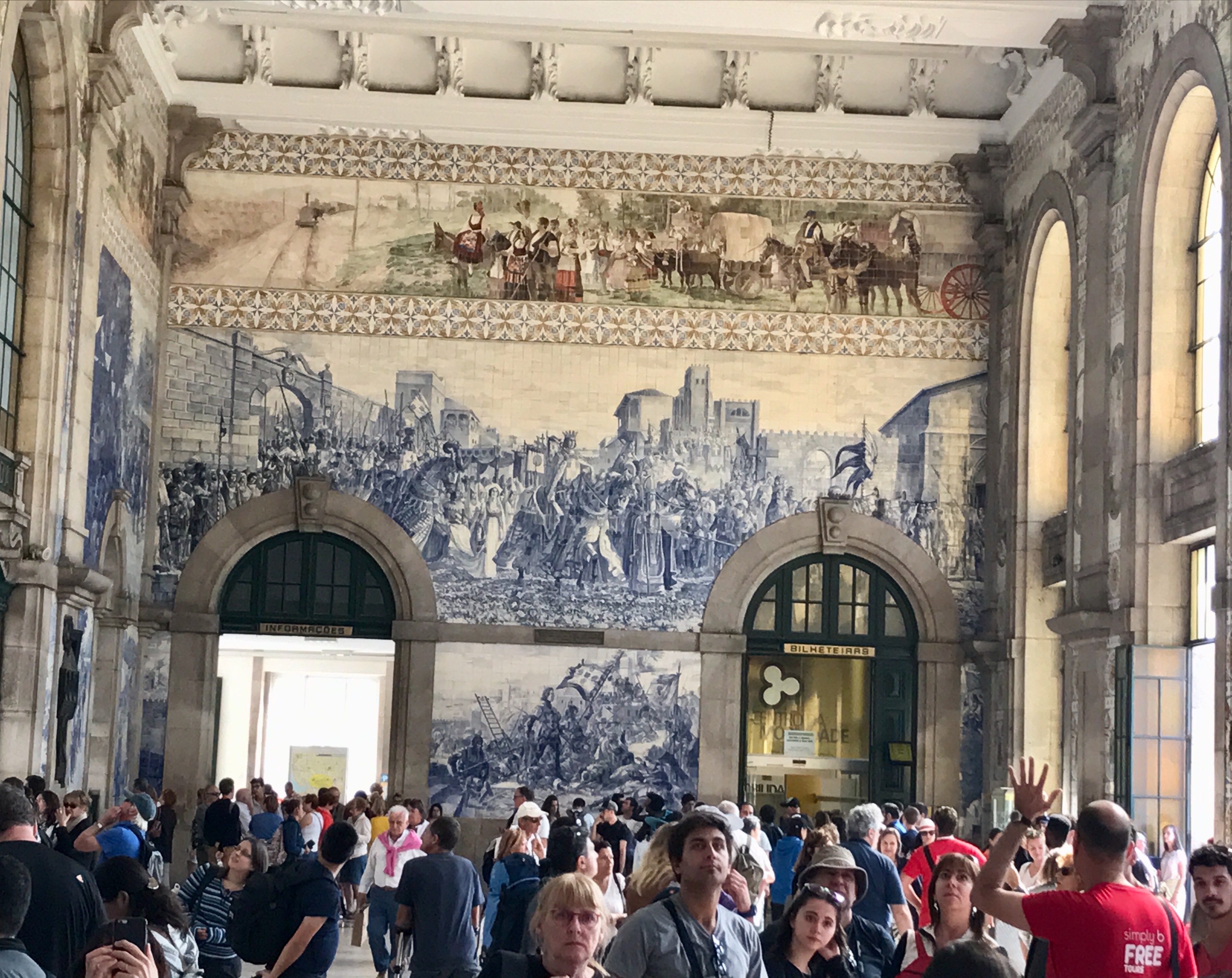
Porto is home to the famous Port wine we all know and love but there is so much more to explore in this lovely city. A train ride away from Lisbon, Porto is the colorful smaller sibling that awaits with open arms. Although comfortable and on time, the train ride was not particularly picturesque or memorable. The best part about the train ride was the arrival to the Sao Bento train station in Porto. The terminal, built in the 19th century, is known for its beautiful terminal covered in over 20,000 mostly blue and white hand painted tiles showcasing medieval warriors. Staying right across from the station proved to be another good choice, within walking distance from most landmarks, restaurants and the waterfront or the Ribeira as most people know this area. Colorfully painted houses, standing next to each other, blue, red, yellow. This is no painter’s mistake, it is done purposefully by the fishermen who paint their boats to match their houses and find their way back easily after an early morning fishing trip. From here you can admire the Dom Luis bridge, an iron two-level structure built by the Gustave Eiffel school that reminds you so much of that lovely tower he built in Paris.
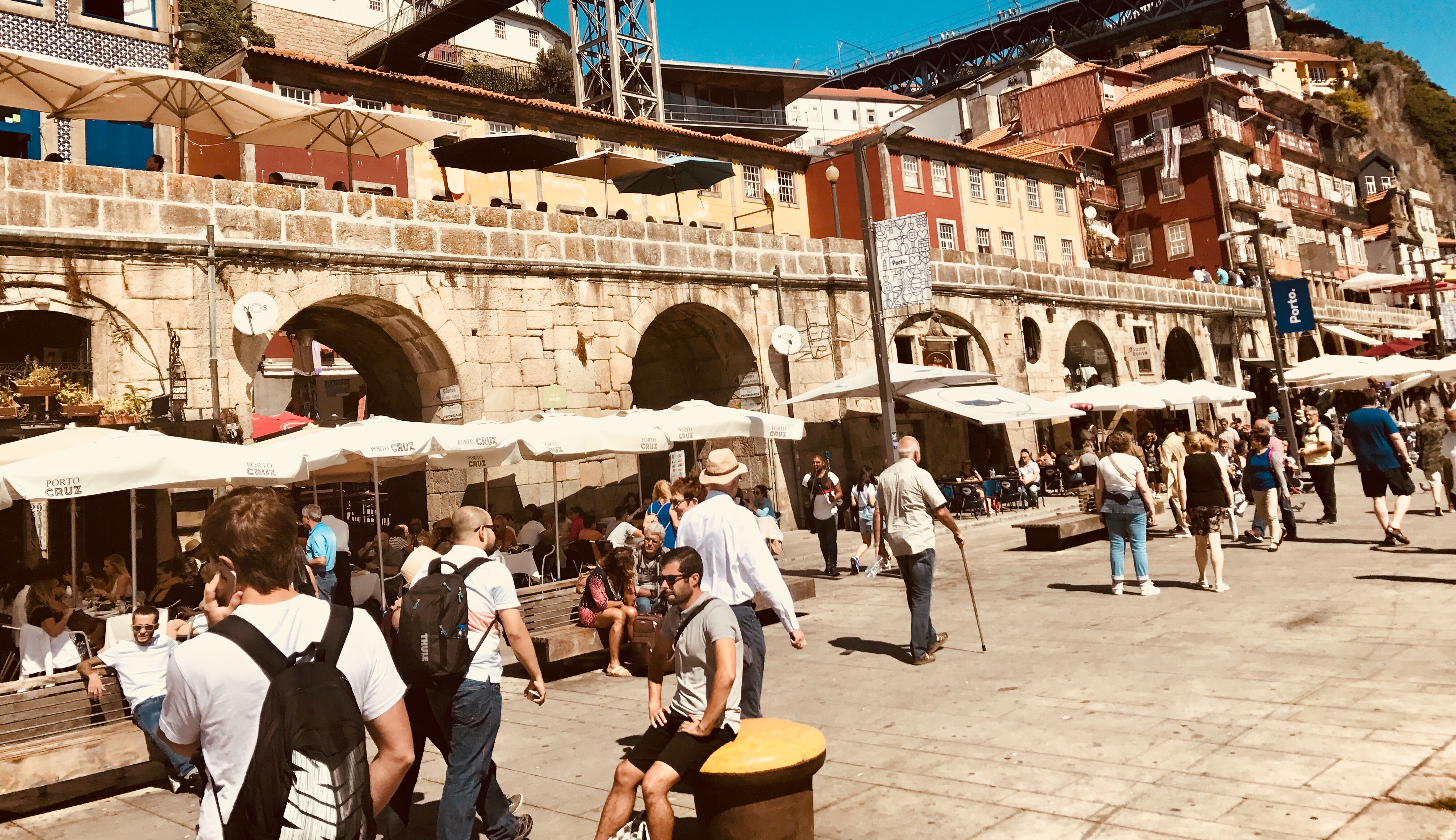 After an afternoon stroll spent visiting the Cathedral, the main square, and the Gaia district across the river, we settled down to enjoy a Francesinha. A local favorite, it can be best described as a mixture of a sandwich and gravy. This calorie-laden delight includes meat slices, sausage, cheese and is topped with gravy and fries to cover all food groups. Strangely enough, it works and is comforting. Locals eat this at least once a week.
After an afternoon stroll spent visiting the Cathedral, the main square, and the Gaia district across the river, we settled down to enjoy a Francesinha. A local favorite, it can be best described as a mixture of a sandwich and gravy. This calorie-laden delight includes meat slices, sausage, cheese and is topped with gravy and fries to cover all food groups. Strangely enough, it works and is comforting. Locals eat this at least once a week.
A tip from a local brings us to a restaurant just across the Sao Bento train station. The place opens at 8:00 p.m. and we get there in time for our reservation but a line has already formed outside the door. The reserved tables get first dibs and if there is space, well, you are invited to stay. Dinner at O’Rapido is like eating at your grandmother’s house. It’s a bit crowded, the tables touch each other but people are friendly and obviously used to this. I decide to start with the local soup “Caldo Verde” the Portuguese Potato and Kale Soup with Sausage, a bargain at 1.50 Euro per plate. Grilled fish follows with the usual accompaniment of cabbage and potatoes. All of it comforting, plentiful and delicious.
I have not mentioned the wine of Portugal but it is more than worth the mention. Most people will know Portuguese wine for its Vinho Verde. Translated as “green wine” it is really named after the region it comes from. Light, airy and somehow fizzy, this wine is easy to drink and perfectly matches the local food. There are so many other good wines to try in Portugal, without forgetting the famous Porto, that it would take another article to talk about it.
Tasting my way through the world can sometimes be overwhelming. Restaurants can be casual and inexpensive or fussy and pricey. How do you remember which one served the best quality and value? Well, for me it is to take extensive notes without becoming obnoxious by photographing every dish (Well, I try not to). Ultimately, I ask myself the make or break question: “Would I come back here for another meal?” In Portugal. I say “SIM!”.
CALDO VERDE RECIPE
- tablespoons unsalted butter
- 2 medium cloves garlic, sliced
- 1 medium yellow onion or large leek, finely diced
- 3 large potatoes, peeled, quartered, and cut into 1/4-inch slices
- Kosher salt and freshly ground black pepper
- 6 cups chicken stock
- 1 bunch kale, stems removed, leaves roughly chopped
- 12 ounces pork sausage, cut into 1/4- to 1/2-inch slices
- Minced fresh parsley
Directions
Heat butter in a large saucepan over medium heat until melted. Add onion (or leek) and garlic, season with salt and pepper, and cook, stirring frequently, until softened but not browned, about 5 minutes, adding olive oil as necessary to keep the mixture loose and moist.
Add potatoes and stock and bring to a simmer, stirring occasionally. Add kale and continue to cook until potato slices have completely broken down, the greens have softened, and the soup has thickened to a creamy consistency, 25 to 30 minutes. Stir in sausage. Season soup to taste with salt and pepper and serve garnished with parsley.


